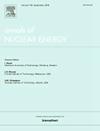Reduced order models for thermal hydraulic transient analysis in nuclear engineering
IF 1.9
3区 工程技术
Q1 NUCLEAR SCIENCE & TECHNOLOGY
引用次数: 0
Abstract
Reduced order modeling emerges as a valuable tool for addressing multi-query challenges in high-fidelity computational simulations, particularly in areas such as design optimization and uncertainty analysis. Given that computational costs pose a primary obstacle to leveraging multi-physics multi-scale integrated systems, achieving computational reduction without compromising calculation accuracy through reduced order modeling offers significant advantages. This study explores two hybrid approaches to reduced order modeling, specifically applied to nuclear thermal hydraulic accident analysis. The first approach involves constructing a reduced order basis through random sampling, followed by the development of surrogate models based on linear regression, second order polynomial regression, and artificial neural network to predict time dependent thermal hydraulic behaviors. The second approach utilizes the reduced basis to transform a solution module within a thermal hydraulic analysis code, assessing the feasibility of the intrusive reduced order modeling approach. A comparison between reduced order model predictions and full order model calculations yields promising results, elucidating applicable conditions and limitations of the proposed approaches.
求助全文
约1分钟内获得全文
求助全文
来源期刊

Annals of Nuclear Energy
工程技术-核科学技术
CiteScore
4.30
自引率
21.10%
发文量
632
审稿时长
7.3 months
期刊介绍:
Annals of Nuclear Energy provides an international medium for the communication of original research, ideas and developments in all areas of the field of nuclear energy science and technology. Its scope embraces nuclear fuel reserves, fuel cycles and cost, materials, processing, system and component technology (fission only), design and optimization, direct conversion of nuclear energy sources, environmental control, reactor physics, heat transfer and fluid dynamics, structural analysis, fuel management, future developments, nuclear fuel and safety, nuclear aerosol, neutron physics, computer technology (both software and hardware), risk assessment, radioactive waste disposal and reactor thermal hydraulics. Papers submitted to Annals need to demonstrate a clear link to nuclear power generation/nuclear engineering. Papers which deal with pure nuclear physics, pure health physics, imaging, or attenuation and shielding properties of concretes and various geological materials are not within the scope of the journal. Also, papers that deal with policy or economics are not within the scope of the journal.
 求助内容:
求助内容: 应助结果提醒方式:
应助结果提醒方式:


